| Home > China Feature |
Shaolin Temple: Taking one''s breath away
Shaolin Temple is regarded as the origin of Chinese kungfu and attracts people all around the world for learning its mysterious martial art.
"Home to the Yellow Emperor, where Buddha's light shines forth from Longmen and Shaolin's kungfu is known to all under heaven welcome to Henan province."
This is the grand greeting you get on your cellphone as you step off the train in the provincial capital of Zhengzhou.
Henan, of course, is the birthplace of the Yellow Emperor or Huangdi, legendary progenitor of the Chinese people. Along the banks of its Yi River are the ancient Longmen Grottoes, one of the finest repositories of Buddhist cave art.
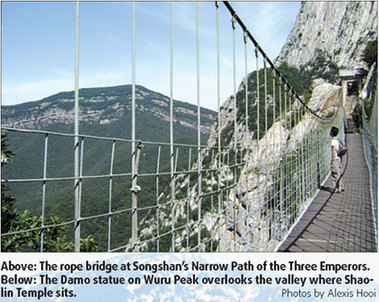
It is also here in Henan that monks of the famed Shaolin Temple are said to practice their formidable form of martial arts, in the shadow of Songshan Mountain.
Songshan itself is the center of the world.
Taoists in the Middle Kingdom consider the mountain a symbol of earth, the central point of the five elements that make up the universe.
With its highest peak of Shaoshi at 1,512m, the looming highland leaves no doubt as to the gravity of its stature and can seem intimidating to visitors at first.
But the adventurous trekker with a full day on his or her hands will be rewarded with a veritable feast of mind-boggling breccia rock formations, gravity-defying chevron faults and breathtaking views of China's central plains - along a seemingly treacherous path that often clings to red- and gray-colored cliff faces dotted with turfs of greenery.
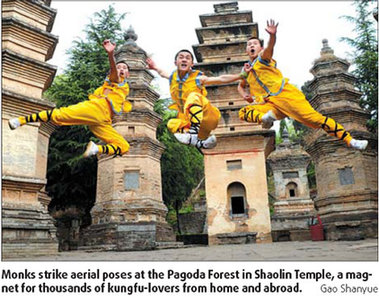
Take a breather on the nearest boulder off the track as you head into the occasional valley and the colossal mountain offers temporary reprieves in the form of whispering brooks, singing cicadas and that welcome waft of cool breeze.
As you continue the climb, look up at the towering grandeur of Heaven's Gorge as it reaches into the clouds and walk weightlessly on the rope bridge along the Narrow Path of the Three Emperors - all else will seem to revolve underneath.
The cardinal position accorded to Songshan is also reflected in the firmly entrenched reputation of Shaolin Temple being the origin of martial arts. Legend has it that the temple's first disciples in the 5th century mimicked the natural motions of birds and beasts as relief between long meditation sessions, a practice that evolved into physical and spiritual combat over the centuries.
In the world of Chinese pugilistic novels and film, Shaolin monks, with their evil-subduing cudgels and diamond-hard fists grounded to perfection through years of tough training, have few rivals in other kungfu sects.
Students of the local 20,000-strong Ta Gou school today still practice wushu on the temple's adjacent dirt fields, while foreigners who also want a bit of the action take up short-term classes to try out moves at the temple.
Those with less time on their hands can be part of about half a million foreigners a year who experience Shaolin's temple halls, Buddhist relics and well-stocked souvenir shops.
Weave through the Pagoda Forest, a cemetery containing the ashes of monks stored in more than 200 pagodas and steles donated by foreign martial arts schools.
Or venture into the adjoining hills west of the temple, where the top of the 750-m-high Wuru Peak is marked by a three-story-tall, white-colored statue of Damo, the patriarch who first taught Shaolin monks martial arts and positioned the temple as the birthplace of Zen Buddhism in China. Close to the top of Wuru lies the cave where Damo sat meditating long enough to apparently leave a shadow on the wall - that slab of the cave is now housed in Shaolin Temple itself.
Even so, Xiao Zhi, a 23-year-old monk outside the Damo grotto, says not everyone gets to see the mystical imprint for what it is. "It's a matter of fate and being in the right frame of mind," he says.
To enjoy these sights at leisure and escape the crowds by wandering the grounds in the early morning or late evening, consider putting up at Wang Zhi Gou, a hamlet of about 30 quaint lodgings south of Shaolin Temple just behind its Arhat Hall. Staying within the 2.18-sq-km Shaolin compound this way also means you save paying for the 100 yuan ($15) entrance ticket again.
The Shaolin Tourism Hotel offers one of the more comfortable options in Wang Zhi Gou, with its refurbished annexes, glass-walled attached toilets and second-floor dining rooms that look out to the hills. Hotel employee Yuan Yanan says there are occasional groups of foreign tourists who stay for up to a year as they take kungfu lessons down the slope.
Still, the town of Dengfeng, about 20 minutes by minibus from Shaolin Temple, ends up as the choice of lodging for most first-time visitors. After an hour-long bus ride from the Zhengzhou train station, the attractions of this sleepy town at the foot of Songshan are worth a brief stop.
Slurp up a hearty bowl of Henan's huimian noodles - proof of why the province is the country's breadbasket - with raw garlic on the side in roadside stalls and fuel up for a visit to Zhongyue Temple, a Qing Dynasty complex modeled after Beijing's Forbidden City that was built to worship the god of Songshan.
Unlike the welcome you receive on your mobile, Dengfeng residents can be typically nonchalant about the area's fame.
"We're all aware of the heritage and history here, being in central China," says Zheng Nanyue, who runs a huimian stall in western Dengfeng.
"But locals don't brag about the attractions, because it becomes obvious once you're at the center of it all."
Art
 more
moreSculpture in Qianling Mausoleum
The sculpture of Qianling Mausoleum is the main relic of the ground ...
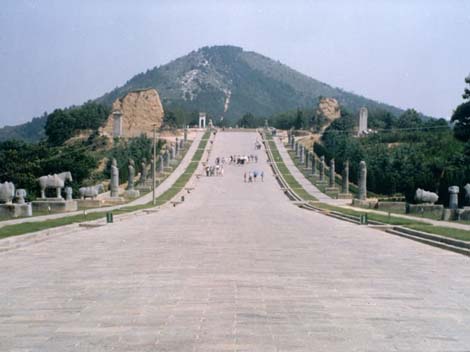
A Sweet Art:Sugar Painting
In and around China’s southwestern Sichuan Province, it is usual to ...
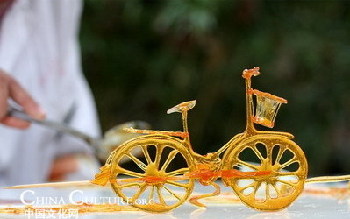
Chinese Treasure Displayed at Sha...
There are four treasures of the Chu Minority Culture displayed at th...
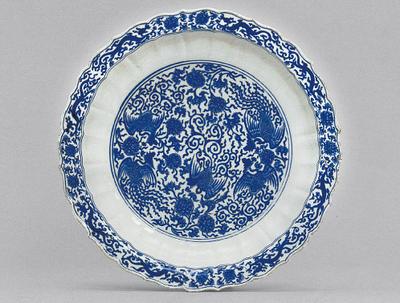
Custom
 more
moreWeb Dictionary
Martial Arts
12 Excellent Kung Fu Movies in 2010 You Shouldn'...
Martial Arts film can be artful and stunningly beautiful, and they...
Shaolin Monks Perform Martial Art in Moscow
A monk from China's Shaolin Temple performs Shaolin mar...
Chinese Kungfu Films Ready for the New Year seas...
The two Chinese blockbusters Let the Bullets Fly and If You Are th...





 print
print  email
email  Favorite
Favorite  Transtlate
Transtlate 







